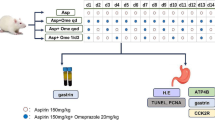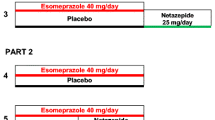Abstract
Omeprazole markedly inhibits basal and stimulated gastric acid secretion and has the ability to produce hypergastrinemia and hyperplasia of enterochromaffin-like cells in humans. On the other hand, paunotol, an acyclic diterpene alcohol, has been reported to inhibit gastrin release by stimulating endogenous secretin release. We investigated the effect of plaunotol on serum gastrin levels after six to eight weeks of omeprazole (20 mg/day) administration in 22 patients (16 males, 6 females; mean age 52.3, range 36–70 years) with peptic ulcer disease. The patients were randomized to the following two groups: 11 subjects with omerprazole alone (single group) and 11 with omeprazole plus plaunotol (240 mg/day) (combination group) treatment. There were no significant differences between the two groups concerning age, sex, ulcer stage, ulcer history, environmental factors, andHelicobacter pylori (HP) prevalence. After complete drug(s) administration, serum immunoreactive (ir) -gastrin levels increased significantly in the single group (P<0.001) in contrast to the combination group, and plaunotol significantly inhibited hypergastrinemia induced by omeprazole administration (P<0.001). Significant increases in serum ir-calcitonin gene-related peptide concentrations were observed in the combination group compared to the single group (P<0.05). However, there were no significant changes in serum ir-secretin, somatostatin, and vasoactive intestinal polypeptide levels as well as ulcer healing and HP prevalence between the two groups. These findings suggest that plaunotol may suppress hypergastrinemia induced by long-term omeprazole administration, at least partly, via a certain brain-gut hormone affecting gastrin release.
Similar content being viewed by others
References
Sachs G.: The parietal cell as a therapeutic target. Scand J Gastroenterol 118(suppl):1–10, 1986
Maton PN: Omeprazole. N Engl J Med 324:965–975, 1991
Ekman L, Hansson E, Havu N, Carlsson E, Lundberg G: Toxicological studies on omeprazole. Scand J Gstroenterol 20(suppl 108):53–69, 1985
Larsson H, Carlsson E, Mattsson H, Lundell L, Sundler F, Sundell G, Wallmark B, Watanabe T, Håkanson R: Plasma gastrin and gastric enterochromaffin like cell activation and proliferation. Gastroenterology 90:391–399, 1986
Okabe S, Tabata K, Kunimi H: Effects of [(E,Z,E)7-hydroxymethyl-3,11,15-trimethyl-2,6,10,14-hexadecateraen-1-ol] (CS-684) on aspirin ulcers in rats and dogs. Pharmacometrics 23:785–788, 1982 (in Japanese)
Shiratori K, Watanabe S, Takeuchi T, Shimizu K: Plaunotol inhibits postprandial gastrin release by its unique secretin-releasing action in humans. Dig Dis Sci 35:1140–1145, 1990
Chiba T, Taminato T, Kadowaki S, Abe H, Chihara K, Seino Y, Matsukura S, Fujita T: Effects of glucagon, secretin, and vasoactive intestinal polypeptide on gastric somatostatin and gastrin release from isolated perfused rat stomach. Gasroenterology 79:67–71, 1980
Lucey MR: Endogenous somatostatin and the gut. Gut 27:457–467, 1986
Ren J, Young RL, Lassiter DC, Rings MC, Harty RF: Calcitonin gene-related peptide: Mechanisms of modulation of antral endocrine cells and cholinergic neurons. Am J Physiol 262:G732-G739, 1992
Kaneko H, Mitsuma T, Kotera H, Uchida K, Furusawa A, Morise K: Are routine cleaning methods sufficient to removeHelicobacter pylori from endoscopic equipment? Endoscopy 25:435, 1993
Kaneko H, Nakada K, Mitsuma T, Uchida K, Furusawa A, Maeda Y, Morise K:Helicobacter pylori infection induces a decrease in immunoreactive somatostatin concentrations of human stomach Dig Dis Sci 37:409–416, 1992
Kaneko H, Mitsuma T, Uchida K, Furusawa A, Morise K: Immunoreactive-somatostatin, substance P, and calcitonin gene-related peptide concentrations of the human gastric mucosa in patients with nonulcer dyspepsia and peptic ulcer disease. Am J Gastrenterol 88:898–904, 1993
Nakata S, Mitsuma T, Iizuka A, Morise K, Kato H: Studies on peripheral plasma VIP levels and VIP release in digestive disease. Gallbladder Pancreas 6:1393–1398, 1985 (in Japanese)
Shiratori K, Watanabe S, Takeuchi T: Role of endogenous prostaglandins in secretin- and plaunotol-induced inhibition of gastric acid secretion in the rats. Am J Gastroenterol 88:84–89, 1993
Watson RGP, Shaw C, Buchanan KD, Love AHG: Circulating gastrointestinal hormones in patients with flatulent dyspepsia, with and without gallbladder disease. Digestion 35:211–216, 1986
Kraenzlin ME, Ch'ng JLC, Mulderry PK, Ghatei MA, Bloom SR: Infusion of a novel peptide, calcitonin gene-related peptide (CGRP) in man. Pharmacokinetics and effects on gastric acid secretion and on gastrointestinal hormones. Regul Pept 10:189–197, 1985
Pappas T, Debas HT, Walsh JH, River J, Taché Y: Calcitoin gene-related peptide-induced selective inhibition of gastric acid secretion in dogs. Am J Physiol 250:G127-G133, 1986
Schwartz TW: Pancreatic polypeptide: a hormone under vagal control. Gastroenterology 85:1411–1425, 1983
Shimoyama T, Fukuda Y, Tonokatsu Y, Abo H:Helicobacter pylori and gastric mucosa. J Jpn Soc Intern Med 82:286–292, 1993 (in Japanese)
Mainguet P, Delmee M, Debongnie J-C: Omeprazole,Campylobacter pylori, and duodenal ulcer. Lancet 2:389–390, 1989
Biasco G, Miglioli M, Barbara L, Corinaldesi R, Di Febo G: Omeprazole,Helicobacter pylori, gastritis, and duodenal ulcer. Lancet 2:1403, 1989
Warren JR, Marshall BJ: Unidentified curved bacilli on gastric epithelium in active chronic gastritis. Lancet 1:1273–1275, 1983
Levi S, Beardshall K, Haddad G, Playford R, Ghosh P, Calam J:Campylobacter pylori and duodenal ulcers: The gastrin link. Lancet 1:1167–1168, 1989
Moss SF, Legon S, Bishop AE, Polak JM, Calam J: Effect ofHelicobacter pylori on gastric somatostatin in duodenal ulcer disease. Lancet 340:930–932, 1992
Wyatt JI, Rathbone BJ, Green DM, Primrose J: Raised fasting serum gastrin in chronic gastritis is independent ofCampylobacter pylori status and duodenal ulceration. Gut 30:A1483, 1989
Satoh K, Kimura K, Yoshida Y, Kasano T, Kihaira K, Taniguchi Y: A topographical relationship betweenHelicobacter pylori and gastritis: Quantitative assessment ofHelicobacter pylori in the gastric mucosa. Am J Gastroenterol 86:285–291, 1991
Takeuchi T, Shiratori K, Watanabe S, Chang J-H, Moriyoshi Y, Shimizu K: Secretin as a potential mediator of antiulcer actions of mucosal protective agents. J Clin Gastroenterol 13(suppl 1):S83-S87, 1991
Author information
Authors and Affiliations
Rights and permissions
About this article
Cite this article
Kandeko, H., Mitsuma, T., Nagai, H. et al. Effect of plaunotol on hypergastrinemia induced by long-term omeprazole administration in humans. Digest Dis Sci 40, 160–165 (1995). https://doi.org/10.1007/BF02063960
Received:
Revised:
Accepted:
Issue Date:
DOI: https://doi.org/10.1007/BF02063960




